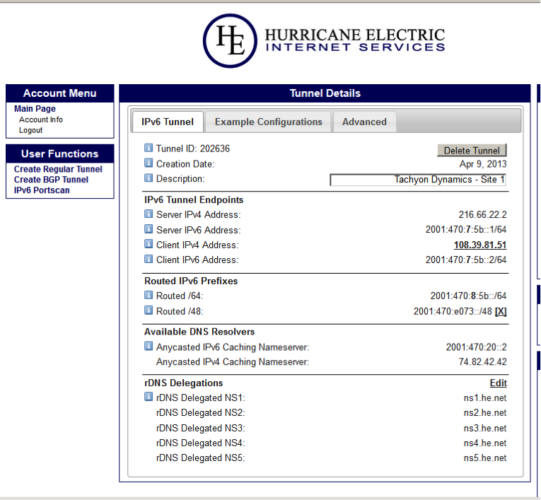
Set Up IPv6 in Your Own Home [Archived]
OUT OF DATE?
Here in the Vault, information is published in its final form and then not changed or updated. As a result, some content, specifically links to other pages and other references, may be out-of-date or no longer available.
Jeremy Duncan, Managing Partner and IPv6 Architect at Tachyon Dynamics, gives his opinion on some good applications and tunneling providers you can use to get IPv6 in your home if your ISP doesn’t offer it already.
IPv6 in home or residential networks is getting much better. North America has seen exponential IPv6 use on the Internet year after year since World IPv6 Launch (6 June 2012). Residential Internet service providers like Comcast and Time Warner are almost singularly responsible for this sharp and dramatic growth. However, if you aren’t a Comcast or Time Warner user, it’s a totally different story. I’m one of those users, and I want to pass on some of the great ways to setup your own IPv6 internet access using one of the great (and free) IPv6 over IPv4 tunnel providers.
Don’t Have IPv6 at Home?
So your ISP is one of any of the minor and major ISPs that have no IPv6 implementation currently. What can one do? Do it yourself! I’ll show you a few applications and tunneling providers to use, as well as ones to never use.
Hurricane Electric
This is probably the best IPv6 in IPv4 tunneling provider out there today. Also, it’s free for small networks. The provisioning is very easy. The graphic below shows how to provision a tunnel and it gives you sample configurations for your gateway of choice. Basically, anything that can do a 6in4 tunnel (IPv4 protocol 41) can use this service. This includes any workstation or server operating system, router, firewall, or custom CPE (e.g. OpenWRT).

Just go to http://tunnelbroker.net. Once there, you can create an account, and select “Create Regular Tunnel.” There it will ask you which PoP you’d like to use and what your public IPv4 source address is. Once you click “apply,” the full configuration screen will be presented and your tunnel is activated and ready to connect. If you aren’t sure how to do tunneling configured you can click “example configurations,” and it will give you the exact CLI configuration needed for your gateway of choice. For example, here is one for a Cisco IOS router:
configure terminal
interface Tunnel0
description Hurricane Electric IPv6 Tunnel Broker
no ip address
ipv6 enable
ipv6 address 2001:db:1:1::2/64
tunnel source 1.1.1.1
tunnel destination 2.2.2.2
tunnel mode ipv6ip
ipv6 route ::/0 Tunnel0
end
Once you have the tunnel up and running, go back into the provisioning page and click “request a routed /48 prefix.” With this prefix you can assign 65,536 /64 network on your home LAN. That will probably be enough for now. :)
Other Hurricane Electric Services:
-
Offers free DNS server for your newly created address space. You can create reverse and forward DNS entries for all the servers and hosts on that network: http://dns.he.net
-
Free IPv6 Sage Training: https://ipv6.he.net/certification/
-
IPv6 BGP peering if your network is larger than a small enterprise or home: [https://tunnelbroker.net/new_tunnel.php?type=bgp.](https://tunnelbroker.net/new_tunnel.php?type=bgp) Also good if you have a Provider Independent Allocation (PIA) from your Regional Internet Registry (RIR).
SixXs
SixXs is more of a community supported tunneling service. They aren’t backed by a large corporate entity like Hurricane Electric, but still provide a few good tunneling services. They were one of the first 6in4 tunneling providers to the industry.
When you navigate to https://www.sixxs.net, sign up for an account. SixXs is very diligent about keeping tunnels up and healthy and are constantly checking on the health. When you have an account you get points for how long your tunnel remains up, and are subtracted points when your tunnel is down. You can cash these points in for /48 prefixes and other little goodies along the way. These incentives keep the overhead of maintaining dead tunnels to a minimum as it is community supported.
Their data rates don’t match Hurricane Electric. I see comparable IPv4 to IPv6 tests with Hurricane Electric, but much slower with SixXs. However, it remains a very good, free, and relevant IPv6 in IPv4 tunneling service. SixXs also provides:
-
Automatic IPv6 Client Utility (AICCU): This is a client-side software application that uses UDP port 5072 to tunnel IPv6 over IPv4 UDP. Certain networks may not allow UDP port 5072 outbound, so use this with care. Details are here: https://www.sixxs.net/tools/aiccu/
-
IPv6 website gateway: This URL-based proxy allows you to connect to IPv6 enabled website using an IPv6 domain name. For example, http://ipv6.google.com.ipv4.sixxs.org will get you to the IPv6 only Google website, but the SixXs gateways will proxy you using IPv4 to your web browser. Details are here: https://www.sixxs.net/tools/gateway/
-
IPv6 Unique Local Address (ULA) registration site: As per RFC 4193, ULA address must not be routable, but must still be globally unique. This site will use the algorithm to generate globally unique addresses, then will register them so organizations can use them later as bogon lists if needed. Details are here: https://www.sixxs.net/tools/grh/ula/
GoGo6
GoGo6 was a company that sprang from Hexago. Hexago was the company that created the appliance-based IPv6 tunnel broker. It was an all in one, and easy to deploy, full tunneling solution. The company is called GoGo6 now and it’s product is called GoGoServer. It offers a free service for users to connect using a client application similar to SixXs, but with more tunneling options: 6in4, UDP port 3653, and DS-Lite. More details on this service is here: http://www.gogo6.com/freenet6/tunnelbroker That client application configuration looks like this:

GoGo6 also offers the following services:
-
Appliance/CPE for the client-side tunneling called GoGoCPE that is sold for a very small cost: http://www.gogo6.com/gogoware/gogocpe
-
You can register for the free IPv6 social network called GoGoNET. Most of the IPv6 industry professionals are here and able to talk and answer questions. Details are here: http://www.gogo6.com/getting-started
-
GoGo6 also has an annual conference where they bring in industry experts and talk about IPv6 issues of the day called GoGoNET Live. Details for that event is here: [http://gogonetlive.com/](http://gogonetlive.com/)
Tunneling You Should Never Do – Ever!
The previous services and providers I mentioned are very good and have a lot of management and oversight around them. However, there are a few services you should never use for the following reasons:
Teredo
Don’t ever enable this. If your Windows machine is on a Windows domain, whatever you do don’t re-enable it. If you have a home PC, then you need to disable it ASAP! Use the DisabledComponents registry key to do this. Just follow this registry path:
HKEY_LOCAL_MACHINE\SYSTEM\CurrentControlSet\services\TCPIP6\Parameters
Now in this path create (or edit) the 32-bit DWORD file DisabledComponents with a decimal value of 1. Then reboot your machine. This setting will disable all IPv6 tunneling mechanisms on your machine. This is best practice for all Windows machines unless it is a DirectAccess Server.
So why is Teredo so bad? One word: control. First, the tunneling mechanism uses UDP port 3544 for client-to-server communication. However, that’s not the only port. Once the server assignes the address to the client it then directs the client to a Teredo relay based on Anycast. This means the client could theoretically be pointed to a Teredo relay anywhere in the world. At this point the Teredo-enabled client can get to the IPv6 Internet through the Teredo relay anywhere in the world. That is the bad part. So I recommend never using it, ever.
-
Disable IPv6 tunneling in DisabledComponents
-
Block UDP destination port 3544 and 3545 on your gateway device
6to4
Don’t ever enable this either. Regardless if your Windows machine is on a domain or not this function is always enabled. However, it will not configure itself unless it has a public IPv4 address. However, if it does have a public IPv4 address, then the Windows machine does not need a server to configure its address. It uses a 6to4 addressing algorithm as explained in RFC 3056. This algorithm from an IPv4 only client to the IPv6 Internet uses the 6to4 prefix, IPv4 public source address, the subnet ID, and the local IPv4 private address. So it looks something like this: 2002:4A7D:2B63: 5EFE::C0A8:0064
When setting up 6to4 on a local LAN, the subnet ID can be configurable, but Microsoft uses the 5EFE subnet ID. Once it auto configures this address the windows machine will go out to ipv6.microsoft.com. That DNS name resolves to the public IPv4 address of the Anycast 6to4 relay. This machine will then be able to go to the IPv6 Internet. The same security problems remains as with Teredo, it could go anywhere in the world.
Recommendations:
-
Disable IPv6 tunneling in DisabledComponents
-
Block protocol 41 on your gateway device
Summary
The residential ISPs are doing better. Between Comcast and Time Warner, users mostly likely have IPv6 in their networks. However, others still trail behind. There are many good and free tunneling solutions from Hurricane Electric, SixXS, GoGo6, for home users to try. However, I recommend to never use Teredo and 6to4 for security reasons outlined above. If you have any questions or comments about this blog please don’t hesitate to reach out to me at jduncan@tachyondynamics.com
 Jeremy has spent over 10 years working in enterprise IT doing next generation technology deployments like IPv6, advanced networking, and open source solutions. He participates regularly with the [North American IPv6 Task Force;](http://www.nav6tf.org/)
often speaking at the North American IPv6 Summits each year. Jeremy spent 11 years in the U.S Marine Corps deploying to Iraq twice during Operation Iraqi Freedom 1 and 2 as a Communications and Information Systems Officer. Jeremy has worked in the DoD with a wide range of information security, network engineering, and network architecture experiences with DISA, JITC, DTRA, and DTIC. He currently leads up Tachyon Dynamics’ DoD UC APL
and [IPv6 training and engineering portfolios.](http://www.tachyondynamics.com/our-services/ipv6-consulting-training/)
He has a Masters of Science in Information Systems and is married with two wonderful children.
Jeremy has spent over 10 years working in enterprise IT doing next generation technology deployments like IPv6, advanced networking, and open source solutions. He participates regularly with the [North American IPv6 Task Force;](http://www.nav6tf.org/)
often speaking at the North American IPv6 Summits each year. Jeremy spent 11 years in the U.S Marine Corps deploying to Iraq twice during Operation Iraqi Freedom 1 and 2 as a Communications and Information Systems Officer. Jeremy has worked in the DoD with a wide range of information security, network engineering, and network architecture experiences with DISA, JITC, DTRA, and DTIC. He currently leads up Tachyon Dynamics’ DoD UC APL
and [IPv6 training and engineering portfolios.](http://www.tachyondynamics.com/our-services/ipv6-consulting-training/)
He has a Masters of Science in Information Systems and is married with two wonderful children.
Any views, positions, statements or opinions of a guest blog post are those of the author alone and do not represent those of ARIN. ARIN does not guarantee the accuracy, completeness or validity of any claims or statements, nor shall ARIN be liable for any representations, omissions or errors contained in a guest blog post.
OUT OF DATE?
Here in the Vault, information is published in its final form and then not changed or updated. As a result, some content, specifically links to other pages and other references, may be out-of-date or no longer available.
